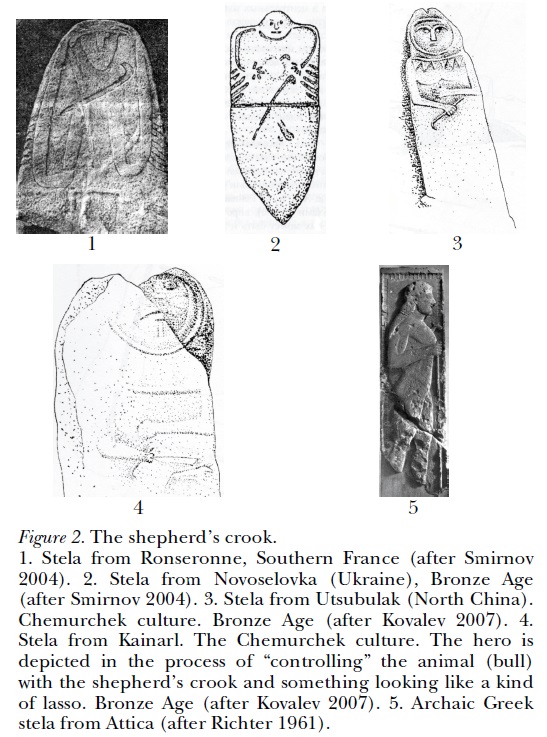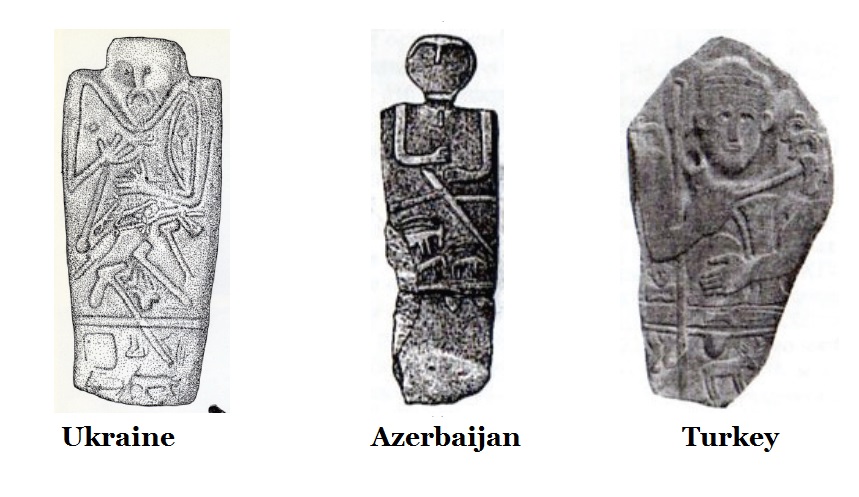The origin, development and importance of Memorial-stones in India (3)

The Chayasthambas: Chaya-sthamba (shadow + pillar) is a memorial pillar bearing the image of the deceased. It implies that the person is dead, but, he / she lives there as a shadow i.e, either spirit or memory lives there as a memorable symbol. The Cayasthambhas of Andhra Pradesh are herostones and memorial stones. Karnataka and Maharashtra contain a large number of sati and hero-stones. This series fall in the early medieval period (5th, 6th century CE. onwards) and have been dated to 5th to 14th-15th centuries CE. The series from Maharashtra does not contain any inscription hence the dating has to be done on stylistic grounds. Apart from these areas, such memorial stones are found in Madhyapradesh, Bihar, Kashmir and Orissa. In Odisha, this form of the Divine Mother is often designated as Stambhesvari (Khambhesvari), or as Kandhunidevi i.e. the deity of the aboriginal Khonds[1]. Parvati is considered as lithic counterpart of Siva Liga and thus, Stambheswari or Khambheswari. That Parvati is also known as Sati, Chaya, Sakti, part of Siva (Ardha-nareswara) and so on. Thus, all these point to Dhakhsyayini episode, from which the Sati concept was evolved.

India-1947 is not the India, studied historically: India of c3500 BCE has been entirely different from that India- 2500 BCE, India – 1000 CE and India – 1947. Sind touching the boundaries of Persia and Arabia, Gandhara, Kashmir, Punjab, Balochistan – on north-west and Brahmadesa, Yuan, and Indo-China on the north-east and thus, India was existing in such a vast geographical area[2]. That is why the Persian and Greek sources say that Darius and Alexander wanted to invade India. They were characteristically mentioned as “India intra-gangem” and “India extra-gangem.” Interestingly, these areas were ruled by the Rajaput warrior class rulers. Thus, Hero-stones are found in these areas. There are certain documents, as pointed out by Edward Pocoke[3], Col. Tod[4] and others that Vikramaditya was ruling parts of Arabia[5]. The similarities between the Greeks and Indians were pointed out by many scholars including William Jones[6], Richard Garb end others. As the Persians, Greeks and Arabs started intruding from c.500 BCE to 712 CE, the Indian kingdoms and dynasties started getting affected by them. With the Islamization, these parts changed completely and with the creation of Pakistan, whatever left out Indian monuments have also been subjected to vandalism and official forceful encroachment and thus, temples have started disappearing. Under such circumstances, the study of Hero-stones and Sati stones is very difficult.

Memorial stones found in Kashmir from the Neolithic period: During the Neolithic period-II, a stone slab with its base 70cm wide was found half buried upside down in a pit at Burzhom[7]. The engraved side was made smooth with proper polishing. Unfortunately, the upper most part of the stone is partially damaged resulting into the loss of the upper part of the engraved scene. The scene depicts five things, Two men, an antelope, a dog and two double-layered circular objects with rays on outer wall like a sun. One man is standing at the rear end of the stag with a long rod-like structure, most probably a spear in the right hand. The second man, shooting an arrow in the chest of the stag is at the front. His left leg is in air crouching back. All these clearly prove that it was a hero-stone, but, now found in a damaged condition. Massive menhiris that can be still found at the site, gritty red ware wheel made Pottery, rubble structures and a few metallic objects were found belonging to this period of Megalithic culture. Thus, the megalithic burial practices continued with Neolithic burial practices and thereafter.

Pre-Mohammedan and Mohammedan monuments of Kashmir: In Kashmir, there were hundreds and perhaps thousands of Memorial / Hero stones and as well as Sati Stones. The earliest examples of memorial stones recorded from Kashmir date back to circa 2nd -3rd century CE. Thus, the reason for such practice has to be analyzed. Here, the narrative would be that of the pre-Mohammedan and Mohammedan periods. The Muslim writers used to interpret in that way dividing the period. They were found in every nook and corner of the Valley, these memorial stones reflect a widespread practice based on the tenets of ‘hero worship’ as well as ‘ritual death’ like ‘Praya’ and Sati. As usual, Kashmiris haven’t documented much, the stones are simply called ‘memorial stones’. Kashmir is known as ‘Satidesh’ (Land of Sati). The mythical origins of the valley come from the story of Sati, the first wife of Shiva who immolated herself. Still, these stone memorials stand testimony to a time when women were burnt alive and then worshipped. When the Mohammedans attacked during the medieval period, the women of that area would have resorted to sati or Jowher to save their honour, just like Rajaput women.


Disappearing Hero stones of Kashmir: One of the first archaeological reports on ancient monuments of Kashmir did mention the probability that these were ‘sati-stones’. Rai Sahib Daya Ram during his survey of monuments of Kashmir in around 1915 wrote: “Another class of antiquities of this late period which are very common everywhere in Kashmir, are a kind of memorial spans which might have been sati stones. […] The face of the slab is divided into two compartments, the upper one containing a standing figure of Bhairava with this usual emblems, and the lower a female figure seated between a bird and a dog, the vehicle of the deity referred to. In some examples, the female is represented as seated by the side of her deceased husband.” Daya Ram in ‘Pre-Muhammadan Monuments of Kashmir’ ascribes the stone slabs to 14th century, the late part of Kashmir History, towards the end of Hindu rule when no big shrines were anymore constructed. Rajatarangini tells us 14th century was a turbulent time as the local powers where constantly at war with each other and Islam was introduced in Kashmir. Men were dying in wars and women were getting burnt. This brings us to the other kind of memorial stones found in Kashmir: the ‘Hero-Stones’ Some memorial slabs kept at SPS Museum, Srinagar. During the administration of Dewan Kirpa Ram [(1826-1830)] Kashmiri Pandits resumed the ancient practice of Sati in all likelihood persuaded by the Sikhs and the Punjabi Hindus[8], because of the Mohammedan atrocities. So these details would become another “Kashmir Files”!


Statues of dead in Tukistan, Central asia: In Turkistan, the hero statues have been found erected like Hero-stones[9]. The researchers accepted that[10] “The custom of making a statue to a dead warrior is reflected in the heroic epic as well.” The statues found of bust size, elongated size etc., resemble hero-stone only, though, the researchers do not mention with such expressions. But, when they were erected to commemorate dead warriors, they come under hero-stones only. As Islam prohibits idol-worship, perhaps, they do not mention with such explicit expressions. In fact, Yaroslav Vassilkov[11] confirms that they are Indian Hero-stones only and they belonged to the Bronze Age. Therefore, a question arises why the Indians living there resorted to such practices there. During that period, whom the Indian heroes were fighting against and getting martyrdom, so that memorials could be built for them. While the controversy of Aryans migrating from Central Asia to Indus Valley and from there to South India has been there and persistently believed even today by the Dravidologists, such events have to be analyzed critically.


Hero-stones at Mizoram: The North-eastern India was facing ethnic and tribal conflicts, at the Chinese were always trying to control other people. Till the medieval – 13th century, the North-eastern India and beyond were part of the “Greater India” and under Indian influence. Thus, the Hero-stones of Mizoram[12] have been interesting to study. The Mizo raised stones over graves in memory of deceased family members[13]. In the case of a chief, the memorial stone is erected at the entrance of the village. There may be two different types of memorials among the Mizo, the stones which are erected over a grave and therefore, connected with burials and another erected at the entrance of the village which are meant only as memorials and have no connection with burials. Besides hero-stones, memorial-type stones are also found in the villages of Mizoram[14]. The Mizo megaliths serve as Memorial stones or Commemorative stones in functionality. The Mizo raised stones in memory of the deceased. The use of wood or stone, or both as memorials to the dead and to the living is also another characteristic feature of this tradition.
© K. V. Ramakrishna Rao
09-05-2024

[1] B. C. Pradhan, Sakti worship in Odisha, Ph. D. Dissertation Sambalpur University, 1983, p. 39.
[2] Now some writers denote it as “Greater India,” Akhanda Bharat etc., but the fact is that “India” of 3500 BCE is bigger than the 1947-India.
[3] Edward Pockoke, India in Greece,
[4] Col.Tod, The Annals and antiquities of Rajastan, Three volumes, Motilala Banrasidas, New Delhi.
[5] Whether the Vikramadiya story is myth, mythistory, mythology etc., or not, he has been so popular and lives among the people even today through many sources. Only Vincent Smith dubbed him as myth and he was consigned accordingly.
[6] William Jones, On the Chronology of Hindus, in The Works of sir William Jones, Vol.IV, pp,1-48, 1789.
P. J. Marshall (Ed.), The British Discovery of Hinduism in the Eighteenth Century, Cambridge university Press, UK, 1970,
[7] Dar, Mohammad Ashraf. “Earliest History Of Kashmir (Archaeological And Geological Perspective).” International Journal of Innovative Research and Advanced Studies (IJIRAS)
Volume 3 Issue 13, December 2016.
[8] R. K. Parmu, A History of Sikh Rule in Kashmir, 1819-1846, Peoples Publishing Co., New Delhi, 1969.
[9] Kubarev, G. V. “Ancient Turkic statues: Epic hero or warrior ancestor?.” Archaeology, Ethnology and Anthropology of Eurasia 29.1 (2007): 136-144.
[10] Sher Ya.A. 1966, Drevnetyurkskie plemena v zerkale arkheologii. In Stepnye imperii Evrazii. St. Petersburg: Farn, pp. 92 – 165.
[11] Vassilkov, Yaroslav. “Indian” hero-stones” and the Earliest Anthropomorphic Stelae of the Bronze Age.” Journal of Indo-European Studies 39.1/2 (2011): 194.
[12] Singh, Salam Shyam. “Hero stones and other archaeological remains of Lianpui Mizoram.” Journal of History, Art and Archaeology 2.1 (2022): 53-62.
[13] Nayan, Sujeet, and Moirangthem Jackson Singh., Menhirs and Petroglyphs of Vangchhia, Indian Journal of Archaeology 7.1 (2022): 53-84.
[14] SINGH, SS. “Archaeological Remains at Zote in Mizoram, in 50 Years after Daojali-Hading: Emerging Perspectives in the Archaeology of Northeast India,

Filed under: Balochistan, Brahmi, Brahmi script, cattle, cattle keepers, cattle raiders, central asia, chronology, conflict, dead, death, hero stone, hero-stone, hindu-kush, kashmir, memorial stone, Mizoram, sati stone, Sind, soul, spirit, statue, stone, tamil, Tamil Brahmi, tamil chauvinism, Tamil inscription, Tamil manuscript, tamil sectarianism, tamil separatism, Turkistan | Tagged: archaeology, azerbaijan, central asia, death, europe, history, India, Kashmir, life after death, memorial for death, mohenjo-daro, Sind, sindhu, soul, transmigration of soul, travel, turkey, Turkistan |


Leave a comment